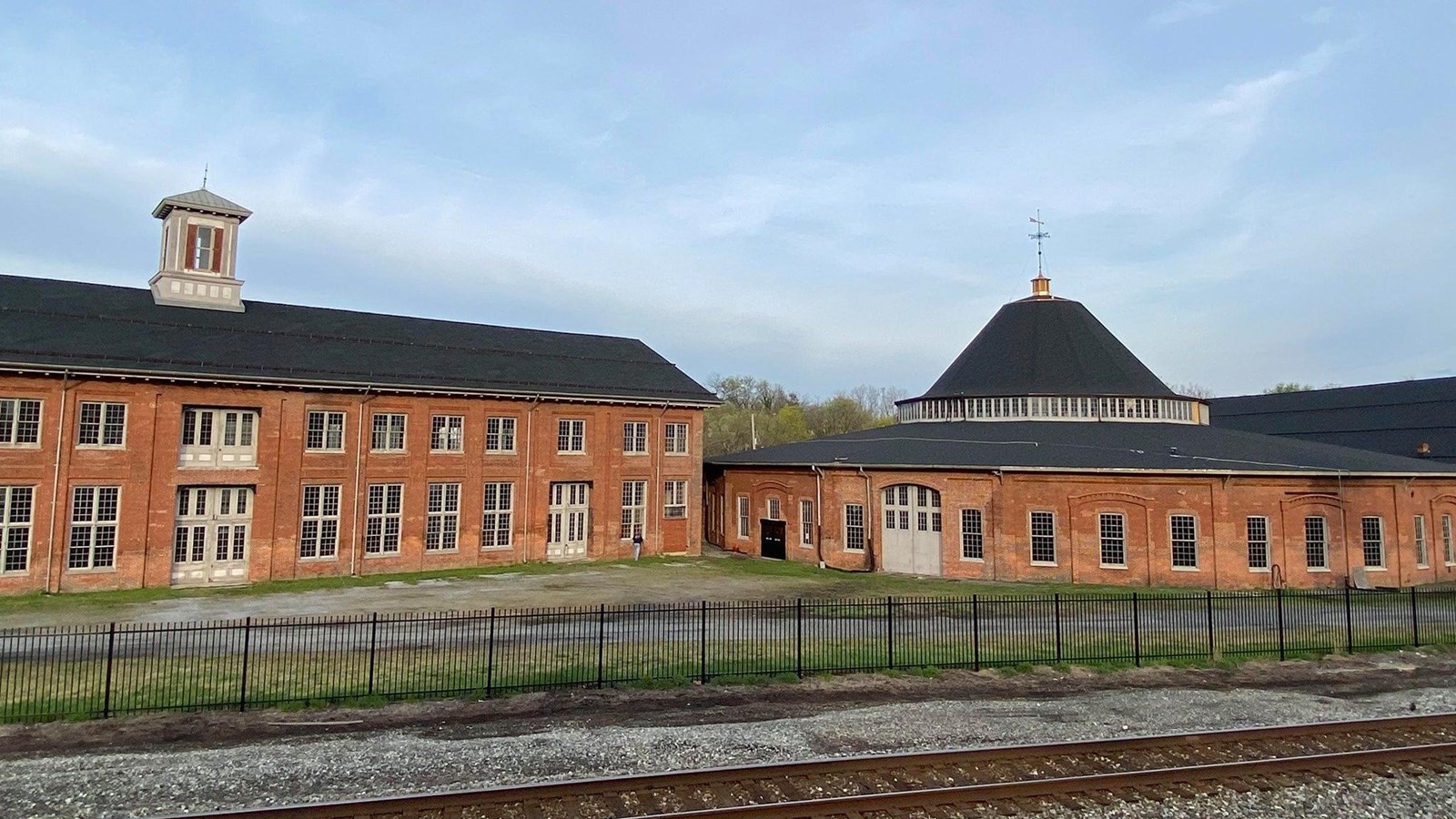Last updated: September 25, 2024
Place
The Baltimore and Ohio Railroad Martinsburg Shops

© Matthew Umstead, used with permission
The Baltimore and Ohio Railroad Martinsburg shops are one of the few remaining examples of innovative nineteenth-century engineering and industrial architecture. Not only is the engineering and architecture important, the laborers who worked here played a major role in the first days of “The Great Railway Strike of 1877,” a pivotal episode in American labor history. The shops sit in a shallow valley along the banks of Tuscarora Creek, in Martinsburg, West Virginia. The B&O Railroad constructed the maintenance complex in 1866, consisting of three buildings: the Machine and Woodworking Shop, the West Roundhouse, and the Car Shop.
Chartered in 1827, the Baltimore and Ohio Railroad was the first public-use railroad in the United States. Begun in Baltimore, the ever-expanding tracks reached Martinsburg on May 21, 1842. In 1848, the railroad began expanding facilities at Martinsburg making it the central maintenance area between Baltimore and Cumberland, Maryland. Construction began with a rectangular engine shed in 1848 on the site of the present shops. The purchase of additional acreage occurred in 1852, and with it, the construction of a machine shop for more serious repairs.
With the onset of the Civil War, the B&O (and consequently Martinsburg) became a strategic target of the competing armies, as the railroad traversed the east-west boundary between the North and South. Confederate troops under Stonewall Jackson destroyed the original Martinsburg railroad shops, roundhouse and depot in mid-1861. After the war, the B&O built the West Roundhouse, Machine and Woodworking Shop, and Car Shop to replace the maintenance facilities destroyed during the war. They are all that stand today.
In 1877, Americans experienced the lowest ebb of a severe economic depression which had been plaguing the country since the Panic of 1873. The frustrations among the country’s labor force reached an explosive level in July 1877, starting with railroad workers responding to a 10-percent wage cut announced by the four major companies--the Baltimore & Ohio, the Pennsylvania, the Erie, and the New York Central and Hudson railroads.
Following an aborted work stoppage by a handful of B&O employees in Baltimore, on the morning of July 16, 1877, railroad workers at the Martinsburg shops also stopped work. After workers began a demonstration at the depot, West Virginia Governor Henry M. Matthews ordered the closest state militia, Colonel Charles Faulkner’s Light Brigade, to contain the situation and restore order. The morning of July 17th, the militia fatally wounded William Vandergriff, a striking fireman, while he was attempting to stop a train from leaving the station.
The murder of a striker outside the Martinsburg Shops helped spark and solidify the violent nationwide protest against the low wages of industrial workers. Spontaneously, and without united leadership, the strike spread to a dozen railroad centers, including Pittsburgh, Baltimore, Chicago, St. Louis and San Francisco. Within a few days, 100,000 men were on strike in the first nationwide labor upheaval in the history of the United States known as the Great Strike.
After two weeks of protest, on July 27 a B&O freight train moved out of Cumberland, Maryland, with an escort of federal troops. It arrived in Martinsburg without incident. The main line of the B&O re-opened in its entirety by July 31.
The overall assessment of who had gained from the strike gave the advantage to the workers. The Great Strike put a stop to wage-cutting experiments--not only on railroads but elsewhere. In August 1877, the B&O started giving the workers home visit leave, as well as reasonable assurances of full-time work. One of the many results of the Great Strike was the growing demand for some kind of federal regulation of railroads.
Designed by renowned nineteenth-century civil engineer, railroad manager, and economist Albert Fink, the West Roundhouse, a polygonal, sixteen-sided building with a domed roof, possesses an early cast-iron framing system that supports the roof. Only from the inside can one see the intricate cast-iron pattern, which resembles a spider’s web. The roundhouse, and railway car turntable within it, provided a more efficient method of locomotive handling and maintenance. Workers inspected, oiled, and fueled each locomotive at the end of a run and brought it to the turntable to be rotated. The structure, built in 1866, is the oldest fully-covered roundhouse in the United States. With its striking silhouette, the West Roundhouse defines the site’s historic role as a railroad complex.
In the late 1860s, architect Johann Niernsee designed the two auxiliary shop buildings, the Machine/Woodworking Shop and Car Shop, which are among the B&O’s most significant remaining structures from the post-Civil War period.
At Martinsburg, although the strike activities unfolded in and around the shops, the complex escaped the destruction that occurred at many other railroad centers during the Great Strike. CSX, the modern owner of the historic B&O, closed the shops in 1985 and sold the complex to the Berkeley County Commission in 1999 for $150,000. The commission transferred ownership to the Berkeley County Roundhouse Authority (BCRA) in 2000. The BCRA, a non-profit, public corporation, restored and redeveloped the site. The Martinsburg Roundhouse is now used for public events and private rentals.
No other sites where strike activity occurred remain as intact as the Martinsburg shops. The Great Strike began on the B&O at this very location and the first strike violence occurred here. The Martinsburg B&O complex is an important site for understanding this watershed event in American labor history.
National Historic Landmark Nomination of the Baltimore and Ohio Railroad Martinsburg Shops
National Historic Landmarks (NHLs) are historic places that possess exceptional value in commemorating or illustrating the history of the United States. The National Park Service’s National Historic Landmarks Program oversees the designation of such sites. There are just over 2,500 National Historic Landmarks. All NHLs are also listed in the National Register of Historic Places.
